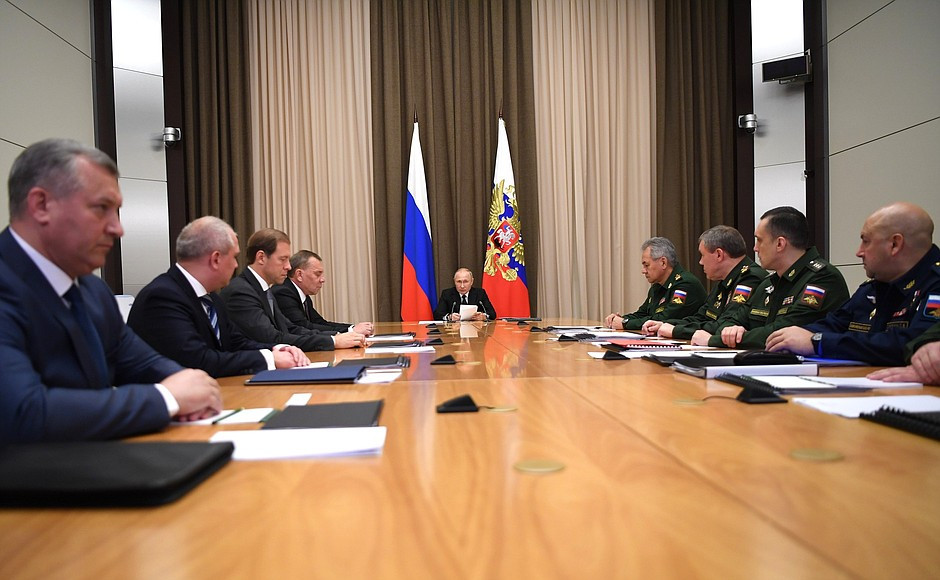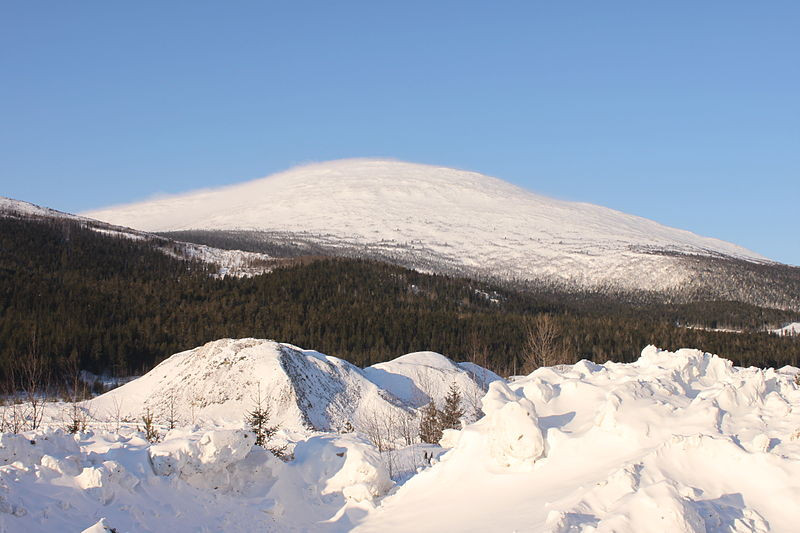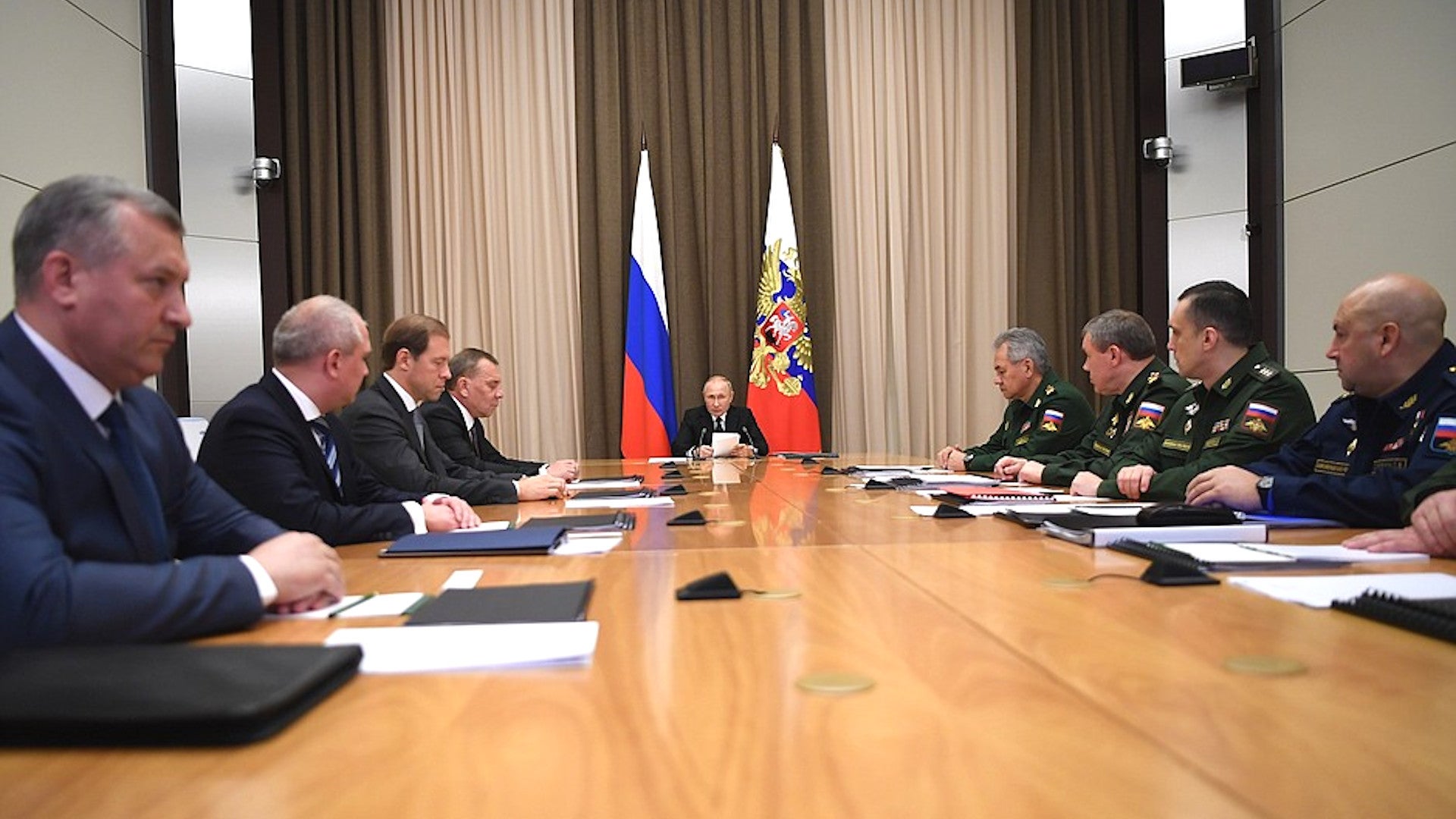The Kremlin has released an unusual transcript of a meeting between Russian President Vladimir Putin and senior defense and other government officials, as well as representatives of Russia’s defense industries, regarding the modernization of the country’s nuclear command and control infrastructure. In it, among other things, Putin disclosed that work on a new hardened strategic command post, possibly a deeply buried underground bunker, is nearing completion.
Putin held the meeting in Sochi on Nov. 11, 2020. Russian Minister of Defense Sergei Shoigu and Russian Army General Valery Gerasimov, Chief of the General Staff of the country’s military, were also in attendance, among others. The day before, the Russian President had held another meeting, which touched on the country’s general nuclear deterrence policy, where he indicated that he would only authorize a nuclear strike in response to one against Russia. This apparent declaration of a so-called “no first use” policy would seem to conflict with previous official statements in recent years.
“It is absolutely clear that the combat capability of the nuclear triad, and the capability of the army and navy on the whole to adequately and quickly respond to potential military challenges directly depend on the stability, effectiveness and reliability of these systems under any circumstances,” Putin said at the Nov. 11 gathering. “I would like to point out that a great deal has been done during the past few years to maintain all the command elements of our strategic nuclear forces at the highest possible level.”

The Russian President made note of improvements to multiple “stationary and mobile command posts” in use across the country. The “analytical and operational capabilities have been expanded, including in terms of information support, monitoring and situation analysis” he explained, adding that “all command posts can receive comprehensive updates in real-time and use them to assess the situation and make substantiated decisions.”
“All equipment, hardware and communication systems of the nuclear forces control systems are regularly upgraded yet remain as simple and reliable as a Kalashnikov rifle,” he continued, making a reference to Mikhail Kalashnikov’s iconic AK-47 assault rifle, famous for its reliability under the toughest conditions, and its subsequent variants and derivatives.
However, Putin outlined further steps that he felt should be taken to make sure that Russia’s nuclear command and control architecture remains intact, “even in the event of a nuclear strike,” thus ensuring the country could launch a retaliatory strike, if necessary. The ability to carry out this kind of a second strike under any circumstances, even after a surprise attack, is a core underpinning of deterrence theory.
The Russian president highlighted three specific areas of interest. One was the need for continued constant exercises and other events to make sure command and control systems are working as intended and that the people trusted with running them know how to properly operate them. Putin also called for efforts to modernize the country’s nuclear command and control architecture.



Most notably, he emphasized a need to ensure the survivability of the country’s nuclear command and control infrastructure. “We are aware that a lot depends on the survivability of these systems and their ability to continue operating in a combat environment,” he said. “They have told me that the creation of an absolutely secure facility for controlling strategic nuclear forces, among others. is nearing completion, and that it will have a very high safety margin.”
It’s not completely clear from these comments whether Putin was talking about an entirely new facility or the refurbishment, improvement, and/or expansion of an existing one. His remarks about the need to protect the overall command and control infrastructure against any threats, including a nuclear attack, strongly point to the site he’s talking about being deeply buried underground bunker of some kind. Russia already understood to have two sites that would match this general description, one at Kosvinsky Kamen in the Northern Ural Mountains and another under Mount Yamantau in the Southern Ural Mountains.
The construction of both sites reportedly began in the late 1970s. It’s worth noting that no facility on earth is totally survivable in the face of strikes by modern nuclear weapons, but deeply buried sites offer probably the best possible defense. As such, the Soviets and the United States both, among others, invested heavily in such bunker complexes during the Cold War, as you can read about more in this past War Zone feature.

Kosvinsky Kamen, at least some portions of which are believed to be buried under around 1,000 feet of solid granite, is probably the better known of the two, due to its connection to a semi-automated nuclear command and control system first developed under the Soviet Union called Perimeter. This system was long described as a “dead hand” doomsday machine akin to the fictional one in Stanley Kubrick’s famous Cold War black comedy film Dr. Strangelove that could carry out an entirely automatic retaliatory launch of Russian nuclear-tipped intercontinental ballistic missiles (ICBM) after an attack.

More recent reporting has indicated that actual humans, who could be pre-authorized in a crisis to launch nuclear strikes if certain conditions were met, were still very much involved in the operation of Perimeter and operated its central components from within the Kosvinsky Kamen complex. That being said, reports still indicate that this main Perimeter bunker was like something you’d find in a villain’s lair in a James Bond movie.
Its main control system was, at least “briefly” situated in “a deep hardened underground bunker in the shape of a sphere, very deep and very hardened, probably the most secure place of all time in the Cold War,” a David Hoffman, a longtime journalist and author of the 2009 book Dead Hand: The Untold Story of the Cold War Arms Race and Its Dangerous Legacy, explained in a podcast in 2015. Duty officers at their posts inside this structure would wait out their shifts watching for three lights to come on.
One would come on when they had received their “predelegation” of authority. The next would confirm a complete “decapitation” of senior Soviet leadership. The last one would become illuminated after confirmation of an incoming nuclear strike. If all three became lit, they would begin initiating the ICBM launches via a secure communications network that included ballistic missile-like rockets carrying transmitters to broadcast launch codes remotely to personnel in silo complexes down below. An actual fully-automated doomsday system was reportedly also considered, but ultimately rejected.
The Soviets reportedly switched on Perimeter operationally for the first time in 1984. At least some portion of the system was reportedly still in operation in post-Soviet Russia as of 2011.
It’s also worth noting that the construction of Kosvinsky Kamen, which is often compared in form and function to the U.S. Air Force’s famous Cheyenne Mountain complex, was not declared to be totally finished until 1996. This was notably followed the next year by the U.S. military’s introduction of the B61-11 nuclear bunker buster bomb. The timing of the introduction of that weapon was widely seen as a direct response to the completion of the Russian bunker complex. You can read more about that bomb and the rest of the B61 series in greater detail in this past War Zone piece.
“Kosvinsky is regarded by U.S. targeteers as the crown jewel of the Russian wartime nuclear command system, because it can communicate through the granite mountain to far-flung Russian strategic forces using very-low-frequency (VLF) radio signals that can burn through a nuclear war environment,” Bruce Blair, who had previously served as an ICBM launch control officer and had worked on communications issues regarding strategic nuclear forces as part of the Congressional Office of Technology Assessment, wrote in The Washington Post in 2003. “Kosvinsky restores Russia’s confidence in its ability to carry out a retaliatory strike.”
Blair, who died in July, had been first to publicly reveal details about Perimeter in 1993 and had gone on to work in the think tank and advocacy communities, including co-founding Global Zero, which advocates for the total elimination of nuclear weapons worldwide.
Less is known about the facility at Mount Yamantau, which reportedly lies, at least in part, under some 3,000 feet of rock, primarily made up of quartz, and has been said to be absolutely massive, encompassing an area “as big as the Washington area inside the Beltway,” or around 400 square miles. The complex is situated within Mezhgorye, which is what is known in Russia as a closed town, where only authorized individuals are allowed to live and work.
This facility is believed to be primarily a so-called continuity of government site for Russia’s top leadership to relocate to during any kind of major crisis, similar to the U.S. military’s Raven Rock Mountain Complex, or Site R, as well as the Federal Emergency Management Agency’s (FEMA) Mount Weather Emergency Operations Center. Raven Rock is generally described as an underground Pentagon, while Mount Weather is meant to provide a hardened location for the U.S. government’s top civilian leadership to operate from.

“It is more a shelter than a command post, because the facility’s communications links are relatively fragile,” Blair had written in 2003. “As it turned out, the quartz interferes with radio signals broadcast from inside the mountain.”
The Russians have been very tight-lipped about this complex, construction of which was still ongoing, at least on some level, as of 1996. “The project has been variously described by present and former Russian officials as a mining site, a repository for Russian treasures, a food storage area, a dump for nuclear materials and a bunker for Russia’s leaders in case of nuclear war,” according to a report that year from The New York Times.
Two years later, it was reported to be abandoned. This raises the question about whether work there subsequently resumed, if any technical issues regarding communications links to the outside world were resolved, and if this is the facility Putin may have been referring to in his remarks today.
Of course, Putin may well be describing another previously unknown site that is now close to being completed.
No matter what, it’s not necessarily surprising that there has been a revival of interest in at least a new-ish, deeply buried nuclear command and control bunker in Russia. For years now, the United States has been pushing ahead with a broad nuclear modernization effort, which includes the new B61-12 nuclear gravity bomb. This is the first variant in that series to feature precision guidance and reportedly has its own bunker-busting capabilities, though it’s unclear how it compares to the more specialized B61-11. The U.S. government has said that it will retain the B61-11 until it had confidence that the B61-12 can supplant it in this role.

President Donald Trump’s Administration also announced in 2018 that it had decided to maintain an operational stockpile of B83-1 nuclear gravity bombs, which have very large yields, reported to be around 1.2 megatons, as an alternative nuclear means of striking at especially hardened facilities. These weapons had previously been slated for retirement.
The U.S. Air Force also has the GBU-57/B Massive Ordnance Penetrator (MOP), a 30,000-pound class conventional bunker-buster designed specifically strike deeply buried targets. You can read more about that weapon and the improvements that have been made to its design in this past War Zone piece.
At the same time, the United States is actively pursuing a variety of conventionally-armed hypersonic weapons. These could be employed in short or virtually no-notice strikes on time-sensitive and other high-value targets, such as less-well-protected sites where the senior civilian and military leaderships of various countries operate on a day-to-day basis.
It is worth noting that there are understood to be at least two underground bunker complexes in Moscow, one under the Kremlin and another nearby, similar to ones in Washington, D.C., plus to more nearby in the Russian capital’s suburbs, but these are nowhere near as deeply buried as the ones at Kosvinsky Kamen and Mount Yamantau. In 2016, there was also a report that Russia was building “dozens” of new bunkers under the Kremlin and elsewhere to support its nuclear command and control infrastructure.
Efforts to develop hypersonic, or kinds of longer-range conventionally-armed strike weapons, look set to further expand in the United States with the collapse of the Cold War-era Intermediate-Range Nuclear Forces Treaty, or INF, last year. Putin and other senior Russian government officials could have concerns that this change in the balance of power presents new threats to the country’s leadership and, by extension, their ability to initiate a nuclear strike.
Just last year, former Soviet leader Mikhail Gorbachev reiterated in an interview with the Moscow Times that there had been a very real belief that the intermediate-range missiles that the INF banned the United States from fielding had presented “the possibility of weapons capable of a ‘decapitation strike’…near our borders.” These kinds of fears have also been cited as possible reasons for the Russian government’s long-standing concerns that the United States could repurpose its Aegis Ashore missile defense sites in Europe to fire offensive strike weapons.
All of this could further underscore the need in the minds of Putin and others in the Russian government for new hardened facilities, as well as the other improvements to the country’s overall nuclear command and control architecture that the Russian President called for in his meeting today. No matter what, with such relatively limited information available to this day about Kosvinsky Kamen and Mount Yamantau, it will be interesting to see what we learn about this newly disclosed bunker, wherever it might be located.
Contact the author: joe@thedrive.com
